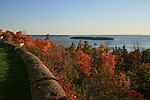Battle of Plattsburgh

The Battle of Plattsburgh, also known as the Battle of Lake Champlain, ended the final British invasion of the northern states of the United States during the War of 1812. Two British forces, an army under Lieutenant General Sir George Prévost and a naval squadron under Captain George Downie converged on the lakeside town of Plattsburgh, New York. Plattsburgh was defended by New York and Vermont militia and detachments of regular troops of the United States Army, all under the command of Brigadier General Alexander Macomb, and ships commanded by Master Commandant Thomas Macdonough. Downie's squadron attacked shortly after dawn on 11 September 1814, but was defeated after a hard fight in which Downie was killed. Prévost then abandoned the attack by land against Macomb's defences and retreated to Canada, stating that even if Plattsburgh was captured, any British troops there could not be supplied without control of the lake. When the battle took place, American and British delegates were meeting at Ghent in the Kingdom of the Netherlands, attempting to negotiate a treaty acceptable to both sides to end the war. The American victory at Plattsburgh, and the successful defense at the Battle of Baltimore, which began the next day and halted British advances in the Mid-Atlantic states, denied the British negotiators leverage to demand any territorial claims against the United States on the basis of uti possidetis, i.e., retaining territory they held at the end of hostilities. The Treaty of Ghent, in which captured or occupied territories were restored on the basis of status quo ante bellum, i.e., the situation as it existed before the war, was signed three months after the battle. However, this battle may have had little or no impact in advancing the objectives of either side.
Excerpt from the Wikipedia article Battle of Plattsburgh (License: CC BY-SA 3.0, Authors, Images).Battle of Plattsburgh
Rue Bonne Fortune, Liège
Geographical coordinates (GPS) Address Website Nearby Places Show on map
Geographical coordinates (GPS)
| Latitude | Longitude |
|---|---|
| N 44.6804 ° | E -73.3756 ° |
Address
Cathédrale Saint-Paul
Rue Bonne Fortune 6
4000 Liège
Liège, Belgique
Open on Google Maps






